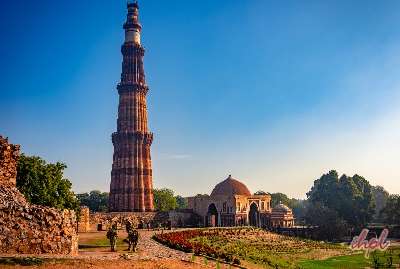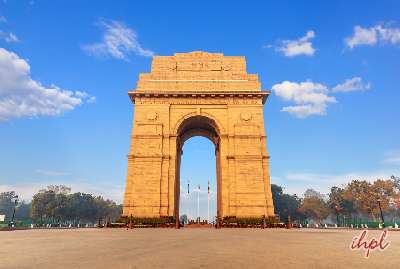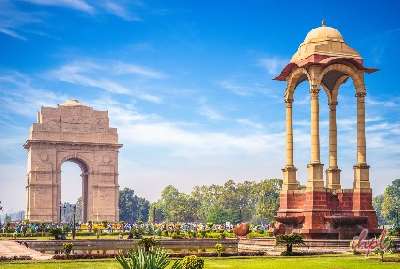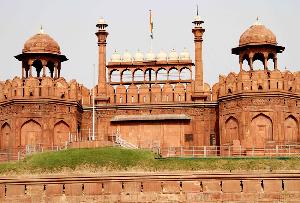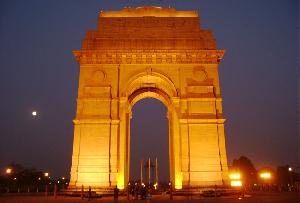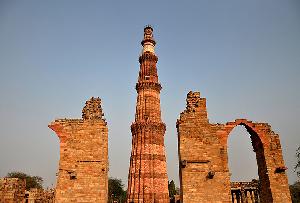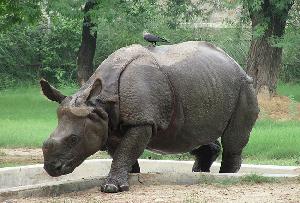Rajghat in Delhi is the cremation site of Gandhiji, Mohandas Karamchand Gandhi, most revered and remembered as the Father of Nation. This memorial is located between the main Ring Road, now known as the Mahatma Gandhi Road, and the banks of the Yamuna River, just southeast of Red Fort. Set amidst deep green lawns and fountains, Rajghat is a must-visit Delhi tourist area, surrounded by a lovely wooded area and several exotic trees creating a serene ambiance.
The mortal remains of Mahatma Gandhi were cremated at this ghat or stepped embankment at the edge of the Yamuna river on 31st January following his assassination while walking to his customary prayer meeting at Birla House.
Structure of Rajghat
The structure of the Samadhi reflects simplicity. The brick platform on which his body had been burned, a black marble platform of some twelve feet by twelve feet square and two feet deep, and a surrounding marble fence was erected, and the shores were landscaped. The last words of Mahatma Gandhi, ‘Hey Ram,’ are inscribed on the memorial platform, which is flanked by an eternal flame.
Earthworks around the cenotaph protect it from flooding the Yamuna. Inside this enclosure, trees were planted, and little square plots of white pebble stones were added for decoration.
There are trees labeled near the platform planted by visiting dignitaries such as Queen Elizabeth II, Ho Chi Minh, former Australian Prime Minister Gough Whitman, and former US president Dwight Eisenhower.
People of every class visit the memorial to pay their homage to Mahatma Gandhi, whom they fondly call the ‘Bapu.’ Good parking facilities are available, and all basic visitor facilities are present.
Explore: Old Delhi Bicycle Tour Package
Life of Mahatma Gandhi
The life of Mahatma Gandhi, the political and spiritual leader of the 1900s, has always been part of history-book stuff. Mohandas Karamchand Gandhi was born on 2nd October 1869 in Porbandar, India. He got married to Kasturba at the early age of 13. He studied law in London and returned to India in 1891 to practice. In 1893, he took on a one-year contract for legal work in South Africa.
Through witnessing the racism, prejudice, and injustice against himself and other Indians in South Africa, Gandhi started to fight for his people’s status and his own place in society. Gandhi stayed in South Africa for 21 years, working to secure rights for the Indian people. He employed a method of action called Satyagraha based upon the principles of courage, non-violence, and truth. He promoted non-violence and civil disobedience as the most appropriate methods for obtaining political and social goals. In 1915, Gandhi returned to India at the end of his contract.
In May 1915, Gandhi founded an ashram on the outskirts of Ahmedabad and called it Satyagraha Ashram, also known as the Sabarmati Ashram. There lodged twenty-five men and women who took vows of truth, celibacy, ahimsa, non-possession, control of the palate, and service of the Indian people. Gandhi’s first major achievements came in 1918 when he started the Champaran agitation and the Kheda Satyagraha.
Using the principles of Satyagraha, he led the campaign for Indian Independence from the British Government. Gandhi was arrested several times by the British for his political activities. He taught the Indians the need for unity among the different religions, languages, and classes of society and used several fasts to advocate the principle of non-violence. The Rowlatt Bill’s denial of civil liberties finally brought Gandhi into active Indian politics. From 1919 to his death in 1948, he occupied the center of the Indian political arena and changed the entire character of the political scene in India.
On 15th August 1947, India was partitioned and became independent. Gandhi refused to attend the celebrations in the capital and went to Calcutta, where communal riots were still raging. On 13th January 1948, at age 78, he began a fast to stop the bloodshed. After five days, the opposing leaders promised to stop the fighting, and Gandhi broke his fast. Twelve days later, a Hindu fanatic, Nathuram Godse, assassinated him.
Fast – Facts:
Here are some facts about the Rajghat which will help you glance at this famous memorial in Delhi. Also, this will make it a lot more convenient for you.
- Location
This memorial is located between the main Ring Road, now known as the Mahatma Gandhi Road, and the banks of the Yamuna River, just southeast of Red Fort.
- Special Feature
A prayer service is arranged for every Friday, when he was assassinated, at 5.30 pm.
- How to Reach Rajghat Delhi
Rajghat, located in the capital city, can be reached from any corner of the country.
- Nearest International Airport: Indira Gandhi International Airport
- Nearest Railway Station: Old Delhi Railway Station
- Nearest Metro Station: Kashmiri Gate
- Nearest Bus Stop: Local buses from various points
Checkout: Delhi Tour Packages
Nearby Attractions
The places near the Rajghat are some of Delhi’s most popular tourist spots. If you plan to visit this famous memorial, keep some time for a trip to these unique sites. Rich in historical and cultural significance, these places are a must-see.
Nearby Attractions of Rajghat in Delhi are Vijay Ghat, Vir Bhumi, Shakti Sthal, Shanti Van, National Gandhi Museum, Zinat-ul-Masjid, Feroz Shah Kotla, and Khuni Darwaza.
- Vijay Ghat
Just near the small artificial lake, to the extreme north of landscaped gardens of Rajghat, is Vijay Ghat, where India’s second Prime Minister, Lal Bahadur Shastri, was cremated in 1966.
- Vir Bhumi
Located next to Rajghat is the memorial of the youngest prime minister of India, Rajiv Gandhi. Rajiv Gandhi was the first son of Indira Gandhi. He was appointed prime minister after his mother’s assassination in 1984. He was assassinated by an LTTE suicide bomber at Sriperumbudur in Tamil Nadu in 1991.
- Shakti Sthal
Located north of Vir Bhumi, Shakti Sthal is the memorial of India’s first and only lady Prime Minister, Indira Gandhi. She was the only child of Jawahar Lal Nehru, India’s first prime minister.
- Shanti Van
It is the memorial of India’s great leader and first prime minister, Jawahar Lal Nehru. It is located to the north of Shakti Sthal and Rajghat. Jawahar Lal Nehru is considered the father of institutional democracy in the country.
- National Gandhi Museum
This two-storey museum is located just opposite the Rajghat. It has a rich collection of photographs, relics, and memorabilia associated with Mahatma Gandhi, as well as books, journals and documents, audio-visual materials, exhibitions, and art pieces.
- Zinat-ul-masjid
It is also known as ‘Ghata Masjid’. Built-in 1707 AD by Zinat-ul-Nissa Begum, the daughter of Emperor Aurangzeb, the mosque is believed to be a replica of the magnificent Jama Masjid on a smaller scale.
- Feroz Shah Kotla
Located near the famous Feroz Shah Kotla Cricket Stadium, it was the majestic citadel of Firozabad, the Fifth city of Delhi. The great builder and Emperor Firoz Shah Tughlaq built the city of Firozabad with its citadel in 1354.
- Khuni Darwaza
Khuni Darwaza, or Bloody Gate, was built by Emperor Sher Shah Suri in the 16th century as one of the gates of his city Shergarh. This double-storied majestic gate got its name after the first war of Indian Independence in 1857 when a British officer killed the remaining descendants of the last Mughal emperor Bahadur Shah Zafar. The bodies were displayed for public viewing before being taken to Kotwali.
This is not all. The places near Rajghat have some of the finest places to eat and shop. Hotel Inter-Continental in Connaught Place, Karim Hotel, Ghantewala sweet shop, food stalls near Jama Masjid, Paranthewali Gali, Natraj hotel, Chor Bizarre of Broadway Hotel, Daryaganj’s Flora, Peshwari, Moti Mahal Restaurant, Workers canteen of Inter-State Bus terminal and legions of roadside food stalls will give a taste of a lip-smacking variety of cuisines. But, of course, the dishes typical to Delhi are not to be missed.
Chandni Chowk for curios, souvenirs, and silver and glass bead jewelry, Nai Sarak for books, Chor bazaar for electronic goods, Daryaganj book market on Sunday, and Chatta Chowk in Red Fort for traditional and contemporary jewelry and handicrafts are famous shopping spots near the Rajghat.




